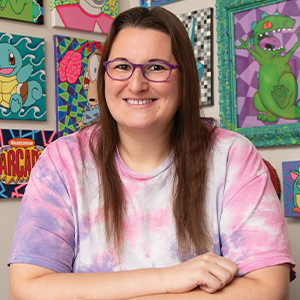Artist and storyteller Leo Bird magnified a scene from his graphic novel for display in “Taking Up Space,” an art show at Mainframe Studios.
Writer: Hailey Allen
Photographer: Duane Tinkey
People have always used art to express themselves, ever since the first Paleolithic artists scratched something in a cave to recount a hunting story or create a family portrait. As humans have evolved, so have our forms of expression. These days art can depict unique experiences and complex emotions for others to see and feel for themselves. It’s a tool for connection as much as creativity.
In June, Mainframe Studios hosted a First Friday art event that showed what it’s like to live with neurodivergence, a broad term that describes differences in neurological function beyond the spectrum of an average human brain. These can be developmental differences like autism, learning differences like dyslexia, or other conditions like obsessive-compulsive disorder.
Since neurodivergence can take so many forms, the aptly titled art show “Take Up Space” embraced the idea that all kinds of neurodivergent lives and experiences deserve to be seen, heard, felt and understood. The event was organized by Momentum Arts Studio, a program through Community Support Advocates that offers a safe and creative place for artists with disabilities to access free equipment, supplies, training, mentorship and community.
After a pair of Momentum artists featured exhibits that explored their experiences with autism, we asked them to tell us what inspired them. The following responses have been condensed and lightly edited for clarity.

Abby Niederhauser, pop culture artist
Abby Niederhauser is a self-taught artist who began drawing and painting for fun after a high school art class. Initially, she began painting her favorite ’90s cartoons and characters simply to decorate her own apartment. But it became her main method of keeping busy, and soon she had produced more than 300 pieces of artwork in various sizes. She began sharing her work under the name Abby’s Rad Art about six years ago.
Taking the name of the “Take Up Space” exhibition literally, Niederhauser displayed some 200 pieces from her home collection along a large wall at Mainframe Studios. She transferred and hung each canvas by hand — she’s an avid puzzler — as a way to showcase the hyperfixation aspect of her autism experience.
Why do you think neurotypical people should witness neurodiversity through art?
It’s important for people to get to know a lot of different people with autism because we’re all so different. My interest in the ’90s has manifested in a way that people can see the intensity and my love for the subject. It’s easy to “get it” when you’re looking at 200 paintings. But not everyone does the special interest thing, and some people are interested in totally different things. I feel like autism is something people don’t understand unless they know somebody who has it or are around people who have it, so I think it’s important to educate yourself by meeting other autistic people.
How has art helped you navigate your autism?
It’s always been hard for me to make conversation. I put up a good front because I know how to mask, but that’s just part of the diagnosis. When I started painting, it was to entertain myself. But then other people started giving me feedback about it, that they really loved the nostalgia factor or the way I painted something. The best conversations I have are when someone compliments my art and wants to talk about the ’90s. It’s really become one of my conversation starters in the outside world.
What feelings or ideas do you hope people take away from your work?
Mostly, I like to just inspire smiles. When people come up and are so excited to look at the subject matter, or they see things they forgot about that they recognize, that’s fun. Whether they buy something or not, people’s appreciation is its own payoff.




Leo Bird, visual storyteller
Leo Bird began sharing his experience with autism in a 2013 memoir called “The Words He Cannot Say.” As he wrote down vignettes of his life and the lessons they taught him, he found ways to share his stories with humor. He began performing at open mics in 2018 and eventually discovered that visual aids could be useful — and at times, funny. He started incorporating drawings into his stories and created a graphic memoir.
Bird’s immersive exhibit at Mainframe featured planks of wood that he had carved and painted to look like people seated at chairs in a cafeteria. Visitors could sit and pretend to eat lunch with the figures in a real-life simulation of one of Bird’s stories, in a way he likened to a humorous haunted house attraction.
Why do you use art to communicate your neurodivergence?
I like using drawings for a lot of reasons. Someone might change their opinion of a situation if they saw it, since images communicate differently than text. Something called “the picture superiority effect” says that people remember information better when it’s presented as images rather than words that mean the same thing. When seeking inspiration for my drawings, I noticed graphic novels were less intimidating than text-only novels. These factors make my visual stories appeal to a larger audience.
How has art helped you navigate your autism?
I learned how to be more outgoing, gained confidence and validation, found more effectiveways of making friends, kept a more positive attitude toward work, and learned better conflict-resolution skills by writing about my life in “The Words He Cannot Say.”
What feelings or ideas do you hope people take away from your work?
I hope people are inspired to join clubs at school, church and libraries. I hope they keep a positive attitude and treat each other with respect. But some parts of “The Words He Cannot Say” were written objectively enough to allow for subjective opinions. Audiences interpret the story with their own experiences, and I learn from audience reactions. I write about times that were happy or awkward but couldn’t put a finger on why, and I keep an open mind to how the audience reacts.
Before I wrote “The Words He Cannot Say,” I thought that fitting in was easy for everyone else. But after sharing my story, I learned that people without autism face the same challenges I did. I was surprised by how willing the audience was to listen and how they even considered my story uplifting. As I’m learning that my challenges are more common among neurotypical people than I thought, the autism theme in “The Words He Cannot Say” seems less important. Autism affects people differently.










